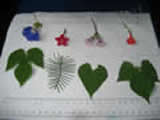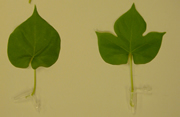Evolution, Genetics, & Ecophysiology of Leaf Polymorphisms
Compared to our understanding of the form, function, and diversity of flowers, we have relatively less understanding about the forces that affect leaf shape, leaf colour, and other aspects of leaf appearance.  Traditional explanations of leaf shape and form emphasize the ir dual roles of acquiring carbon and minimizing water loss. Yet one of the more striking observations of the natural world is that plants have evolved a diversity of leaf sizes, shapes, colours, and forms, both within and between species. Is all of this diversity driven by physiological demands, or might there be other, additional selective agents ?
Traditional explanations of leaf shape and form emphasize the ir dual roles of acquiring carbon and minimizing water loss. Yet one of the more striking observations of the natural world is that plants have evolved a diversity of leaf sizes, shapes, colours, and forms, both within and between species. Is all of this diversity driven by physiological demands, or might there be other, additional selective agents ?
 In this area, we are actively investigating several related hypotheses. Is the appearance of leaves primarily dictated by the physiological requirements of carbon gain and minimizing water loss, or does leaf appearance also perform other functions, such as minimizing herbivore damage ? Do herbivores, which can recognize and learn about different leaf shapes, actually impose natural selection on leaf shape ? How strong is herbivore-related selection compared to selection ascribed to more traditional, eco-physiological agents?
In this area, we are actively investigating several related hypotheses. Is the appearance of leaves primarily dictated by the physiological requirements of carbon gain and minimizing water loss, or does leaf appearance also perform other functions, such as minimizing herbivore damage ? Do herbivores, which can recognize and learn about different leaf shapes, actually impose natural selection on leaf shape ? How strong is herbivore-related selection compared to selection ascribed to more traditional, eco-physiological agents?
 We have been working on these questions in two study species: Hydrophyllum virginianum, and Ipomoea hederacea. In Hydrophyllum virginianum, we have been testing Givnish’s (1990) hypothesis that leaf mottling in early season plants serves to reduce the amount of herbivore damage by providing camouflage. Results to date indicate that mottled leaves suffer appreciably less herbivore damage than do unmottled leaves.
We have been working on these questions in two study species: Hydrophyllum virginianum, and Ipomoea hederacea. In Hydrophyllum virginianum, we have been testing Givnish’s (1990) hypothesis that leaf mottling in early season plants serves to reduce the amount of herbivore damage by providing camouflage. Results to date indicate that mottled leaves suffer appreciably less herbivore damage than do unmottled leaves.  We are currently working on growing H. virginanum from seed to perform common garden experiments to test for genetic variation in mottling, within and between populations.
We are currently working on growing H. virginanum from seed to perform common garden experiments to test for genetic variation in mottling, within and between populations.
In Ipomoea hederacea, we are working on the genetics, physiological ecology, and evolution of a simple, uncharacterized Mendelian polymorphism for leaf shape. Leaf shape in this species follows a latitudinal cline, and we are currently evaluating whether this cline is the result of stochastic or adaptive processes using molecular markers.  We are also investigating potential selective agents on leaf shape, including herbivory and the effects of leaf shape on thermal and water relations. Because of the simple Mendelian nature of leaf shape, in this system it is possible to examine the phsyiological consequences of leaf shape variation in large, recombining genetic populations. Much of our phsyiological work is done in collaboration with Rowan Sage and his laboratory.
We are also investigating potential selective agents on leaf shape, including herbivory and the effects of leaf shape on thermal and water relations. Because of the simple Mendelian nature of leaf shape, in this system it is possible to examine the phsyiological consequences of leaf shape variation in large, recombining genetic populations. Much of our phsyiological work is done in collaboration with Rowan Sage and his laboratory.
